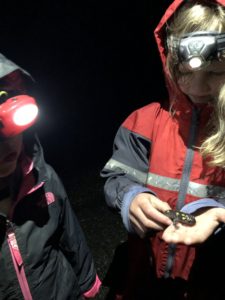By Phil Brown, Director of Land Management
March 19, 2020
I’ve always been fascinated by salamanders. Perhaps because of their extraordinary colors or patterns, or maybe because of their elusive nature, hiding under logs and usually only emerging from the earth by nightfall. Soon, these cool-bodied (and not typically slimy) and gentle creatures will be stirring, emerging from the earth as it thaws, and congregating in numbers in vernal pools to breed and lay eggs. Across our region, several species of amphibians – salamanders and frogs – will make their first appearances on the first rainy evening of the ‘spring’. How one defines spring, especially this year, is up for much debate. After all, it has been snow-free for several weeks in my part of the state, the Monadnock Region, and we just got a fresh coating of several inches of snow on this first calendar day of spring!

The anticipation and excitement of the ‘Big Night’ is what I’m talking about. It usually falls anywhere from the last half of March to the last half of April, depending upon the year and where you live in the state. However, there have been some ‘Little Night’ movements even in late February and early March within the past few years, including this one. Now, with much snow melted and spring having arrived, we are safely within the window of a Big Night when a mass amphibian migration across our roads may occur. Be ready as it could arrive on the next warm (high 30’s or warmer) rainy evening in many areas of southern NH and lower elevations of northern NH.
Wherever I have lived in NH, I have sought out a place where amphibians cross a road, preferably, my own road (so I could avoid the fatal mistake of squishing these migrants with four large tires). Instead of driving, I opt to set out by foot just after dark in raingear, a reflective vest, warm clothes, a pair of waterproof boots, and a strong flashlight. I seek out places that include a combination of woodland and wetland habitats.
As a parent, I have come to realize that there is no other more exciting ‘stay local’ nature-based activity for my kids to partake in! We slowly walk the roadside shortly after sunset and scan the pavement by headlamp and flashlight for aberrations in the surface or color differences. Sticks and stones often fool us into thinking we’re seeing long and narrow spotted salamanders and small, round peepers, but with careful and methodical searching on a big night, we may come across dozens of individuals of up to six or seven species! The tiny spring peeper, the size of a thumbnail, is typically the most abundant frog, and red-spotted newts are often the most numerous salamander. With clean and moist hands, we carefully help them cross the roads in the direction they appear to be heading. The cold, wet road surface tends to slow these creatures down; thus, they are more susceptible to becoming roadkill – a fate that is met by far too many each spring. My kids revel in the fact that they are saving animal lives, and, there’s nothing cooler than handling a large, wriggly spotted salamander – always the top prize! There is no better time to engage with this new, rewarding activity in your own neighborhood. Maybe you will start your own spring tradition.
